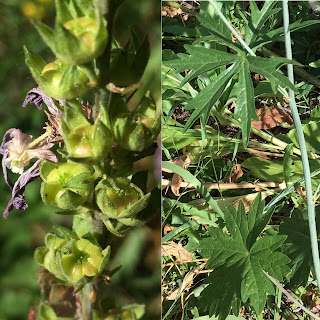 |
| Yampah flowers |
I've been searching for this plant for a while now.
Perideridia gairdneri is known by the common name of
Yampah, and was a favorite food for many American Indian tribes. I first found small amounts of the plant, but I was impressed by its scent, and after reading up on it, I knew it was a plant I wanted to seek out and try. Now I have finally found it in enough abundance to harvest some. I'm not telling where.
 |
Yampah leaves, already withered
when in full flower |
I'll start with how to identify it. First, it has the compound umbels which all members of the carrot family have. It can be difficult to distinguish different members of the carrot family from each other, and from the few poisonous species, but Yampah has a few things which set it apart. These are the white flowers, and especially the leaves. It almost looks as if it has no leaves, but if you look closely, you will find one or two ternately (divided into threes) compound leaves with long narrow leaflets. These may be at the base or halfway up the stem. Often they will already be brown and withered or even fallen off before the flowers are done blooming. The long narrow leaflets are rare in the carrot family. If you find long narrow leaflets, but the flowers are yellow, you probably have Lomatian triternatum (ternate desert parsley). Finally, dig up the roots. Fortunately they are not very deep. The stem seems to go down an inch or two to the top of a fleshy, fascicled root. The "fascicled" is the important thing to look for. It means they grow in clusters, sometimes singly, but often in pairs, and rarely in threes (in my experience so far).
 |
| A variety of Yampah root shapes |
The roots are the main edible part. Mine were about a half inch wide and up to two inches long. When raw, they are crisp and sweet, and have a tinge of minty-anise flavor. When boiled for 10 minutes, they are soft like potatoes, but with much more flavor to them. The raw flavor mellows slightly, and they still have the pleasant sweetness flavor, like a seasoned potato. Some people compare it to a parsnip. I really enjoyed the flavor, and thought they were excellent just as they were, without adding the oil or salt which a lot of other roots seem to need.
Also, the flowers and seeds are very pleasantly aromatic, and would be a great spice to add to meals. I think crushing the flowers releases the scent of fresh carrots, and the seeds have been compared with caraway. I am saving my seeds for use in spicing up some other dishes.
There is a very informative article on Yampah at
cultivariable.com. He says the roots are propagative, so you can replant the smaller ones, or even break off the bottom of the root and replant the top part. Nutritionally, they have lots of starch, like most roots, and are high in vitamin C and potassium, and also have a good amount of protein.




